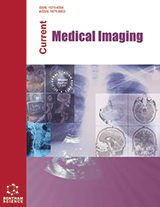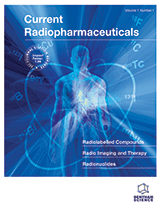Abstract
Combined positron emission tomography (PET) or single photon emission computed tomography (SPECT) with computed tomography (CT) has been rapidly developed because of unique physiological information benefits from a precise topographic localization. PET/CT has been more accurate that anatomical imaging for diagnosing, staging, restaging and assessing therapeutic responses in a large number of different cancers. SPECT/CT has been somewhat overlooked since the procedures with single-photon tracers still constitute the majority of everyday nuclear medicine practice. Besides of precise localization of the lesions CT findings also characterize the abnormalities. Many existing and potential areas of clinical applications as well as translational researches using PET/CT and SPECT/CT are briefly reviewed.
Current Medical Imaging
Title: FDG-PET/CT and SPECT/CT in Oncology
Volume: 4
Author(s): E. Edmund Kim, David J. Yang and Franklin C. Wong
Affiliation:
Abstract: Combined positron emission tomography (PET) or single photon emission computed tomography (SPECT) with computed tomography (CT) has been rapidly developed because of unique physiological information benefits from a precise topographic localization. PET/CT has been more accurate that anatomical imaging for diagnosing, staging, restaging and assessing therapeutic responses in a large number of different cancers. SPECT/CT has been somewhat overlooked since the procedures with single-photon tracers still constitute the majority of everyday nuclear medicine practice. Besides of precise localization of the lesions CT findings also characterize the abnormalities. Many existing and potential areas of clinical applications as well as translational researches using PET/CT and SPECT/CT are briefly reviewed.
Export Options
About this article
Cite this article as:
Kim Edmund E., Yang J. David and Wong C. Franklin, FDG-PET/CT and SPECT/CT in Oncology, Current Medical Imaging 2008; 4 (1) . https://dx.doi.org/10.2174/157340508783502769
| DOI https://dx.doi.org/10.2174/157340508783502769 |
Print ISSN 1573-4056 |
| Publisher Name Bentham Science Publisher |
Online ISSN 1875-6603 |
 13
13
- Author Guidelines
- Bentham Author Support Services (BASS)
- Graphical Abstracts
- Fabricating and Stating False Information
- Research Misconduct
- Post Publication Discussions and Corrections
- Publishing Ethics and Rectitude
- Increase Visibility of Your Article
- Archiving Policies
- Peer Review Workflow
- Order Your Article Before Print
- Promote Your Article
- Manuscript Transfer Facility
- Editorial Policies
- Allegations from Whistleblowers
Related Articles
-
The Anti-Oxidant Properties of Isothiocyanates: A Review
Recent Patents on Endocrine, Metabolic & Immune Drug Discovery (Discontinued) Targeting the Ubiquitin-Proteasome Pathway: An Emerging Concept in Cancer Therapy
Current Topics in Medicinal Chemistry Pore-forming Peptides: A New Treatment Option for Cancer
Current Medicinal Chemistry Using the Neurosphere Assay to Quantify Neural Stem Cells In Vivo
Current Pharmaceutical Biotechnology Synthetic and Application Perspectives of Azapodophyllotoxins: Alternative Scaffolds of Podophyllotoxin
Current Medicinal Chemistry Transcervical Oropharyngectomy: A Clinically Focused Review
Current Cancer Therapy Reviews Dendritic Cell Immunotherapy for Malignant Gliomas
Reviews on Recent Clinical Trials Effect of Oxidative Stress on the Pharmacokinetics of Clomipramine in Rats Treated with Ferric-Nitrilotriacetate
Drug Metabolism Letters Stem Cells: An Overview of the Current Status of Therapies for Central and Peripheral Nervous System Diseases
Current Medicinal Chemistry Looking at Drug Resistance Mechanisms for Microtubule Interacting Drugs: Does TUBB3 Work?
Current Cancer Drug Targets Pin1: A New Genetic Link between Alzheimer’s Disease, Cancer and Aging
Current Aging Science Oligonucleotides and G-quadruplex Stabilizers: Targeting Telomeres and Telomerase in Cancer Therapy
Current Pharmaceutical Design Traditional Chinese Medicine - Sea Urchin
Mini-Reviews in Medicinal Chemistry Regulation of Autophagy by Sphingolipids
Anti-Cancer Agents in Medicinal Chemistry Computer-Aided Drug Design Applied to Secondary Metabolites as Anticancer Agents
Current Topics in Medicinal Chemistry The Induction and Repair of DNA Interstrand Crosslinks and Implications in Cancer Chemotherapy
Anti-Cancer Agents in Medicinal Chemistry An Agathokakological Tale of Δ<sup>9</sup>-THC: Exploration of Possible Biological Targets
Current Drug Targets Recent Advances in Metal-Organic Frameworks as Anticancer Drug Delivery Systems: A Review
Anti-Cancer Agents in Medicinal Chemistry Targeting AMPK Signaling Pathway to Overcome Drug Resistance for Cancer Therapy
Current Drug Targets Synthesis of 99mTc-Nimotuzumab with Tricarbonyl Ion: in vitro and in vivo Studies
Current Radiopharmaceuticals










